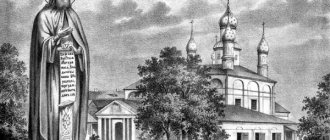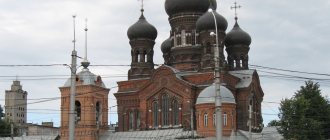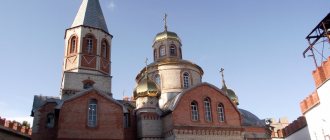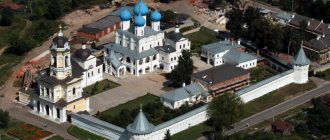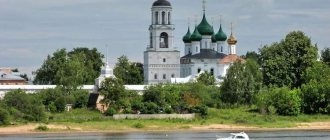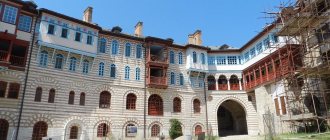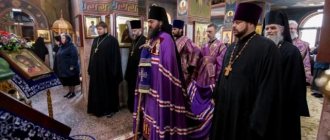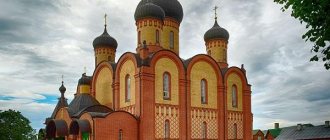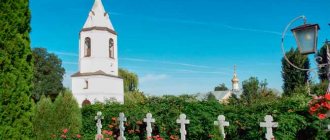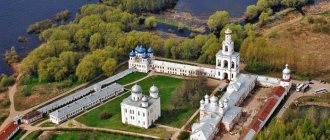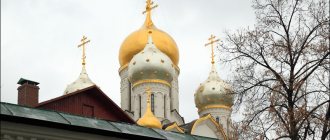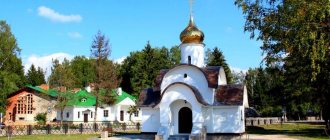One of the most ancient Russian monasteries - the Vvedensky Vladychny Convent of the city of Serpukhov - was founded back in 1360 by Metropolitan Alexy, the saint of Moscow and the wonderworker of all Rus'. The monastery chronicle tells that he once heard a voice that came from the icon of the Mother of God. And this voice told him that he should build a monastery.
Moreover, the place was precisely indicated - near the city of Serpukhov, in the middle of a pine forest, on the right picturesque bank of the river flowing there with the name Nara. And even an event from the earthly life of the Mother of God was indicated, in honor of which it was necessary to build and name the monastery: the Entry into the Temple of the Blessed Virgin.
How people followed instructions from above
And so Alexy sent there his best cell attendant, whose name was Varlaam, so that he could inspect the place indicated in such a wonderful way. It so happened that Varlaam had to spend the night there, and in a dream he heard a strong ringing. So he realized that this was the place to which the Mother of God pointed.
After some time, Alexy himself arrived there and, having also heard the beautiful ringing, decided to build a monastery right here, in this amazingly beautiful place.
On his instructions, a simple wooden church was built here, and two years later - a stone one. The Monk Varlaam became the first Abbot of the monastery. It was Varlaam who indicated that he would be called by the name of the Lady Mother of God.
Monastery of St. Alexis
The Vvedensky Vladychny Monastery arose by the special will of the Mother of God. One day, the Metropolitan of Kiev, Saint Alexy of Moscow, heard a voice coming from the icon of the Mother of God : “Alexy, it behooves you to build a monastery in my name, and also in memory of yourself.”
Miraculously, the place for construction was also indicated “within the city of Serpukhov, in a dense pine forest.” The saint examined the proposed surroundings; he did not like the place. And suddenly at night the Metropolitan again heard a voice commanding that the monastery be built exactly there - not far from the confluence of the Oka and Nara rivers.
Alexy ordered the foundation of a wooden church in the indicated place, appointing his cell attendant Varlaam as the builder. So Varlaam Serpukhovsky became the first abbot of the new monastery. In 1362, through his labors, “a stone church was built,” consecrated by Metropolitan Alexy in honor of the Entry of the Most Holy Theotokos into the temple.
After his death, Saint Varlaam, buried in the monastery, became its heavenly intercessor.
Temple-fortress, protector of Holy Rus'
In the 15th century, during the times of frequent Tatar raids, in order to protect themselves from enemies, the gentle banks of the river flowing near the temple were strengthened with a fence made of pointed logs - a fort. And of course, the monastery itself took on the appearance of a fortress - it was fenced with a massive wall and embrasures. There were cannons in the courtyard in case of an attack by enemy troops.
Throughout its history, many times the holy church has found itself at the center of hostilities. So in 1598 it became the center of location for Boris Godunov’s soldiers, who were preparing for battle with the Crimean Tatars. The legend says that St. George the Victorious himself appeared to provide his heavenly protection to the monastery and the city.
On a magnificent white horse, he rode out of the monastery gate and approached the enemy troops. Seeing the Saint standing up to defend Serpukhov, the enemy retreated in fear. And Saint George returned to the church again.
In honor of this significant event, a two-tiered stone temple was erected with the money of Boris Godunov. According to ancient legend, a candle spontaneously lit up in front of the icon of the Holy Protector if something threatened the inhabitants of the monastery.
Shrines that perform miracles
In 1377, an icon of amazing power was specially painted for the Vladychny Monastery: “The Entry of the Most Holy Theotokos into the Holy of Holies.” Located in the most honorable place of the cathedral church, it was considered its most important shrine and was revered by believers as healing and miraculous.
In 1599, another church was built above the Holy Gates - the church of the holy martyr Theodotus of Ancyra, who accepted death, but did not renounce his Christian faith. This church was later slightly rebuilt, and Moscow Saint Philaret consecrated it in honor of the Image of the Savior Not Made by Hands.
According to legend, the icon of the holy martyr John the Warrior was kept in the monastery building. In 1382, when the enemy managed to end up in the temple, one of them began to saw her with a laugh. Suddenly, blood began to flow from the icon, and the board itself surprisingly quickly came together at the place where it was cut. In surprise, the barbarian recoiled and turned to Jesus in prayer.
A little later, a special frame was made for this icon so that the places where it was cut and the blood that appeared on it could be seen.
In 1607, a new face of Demetrius of Uglich appeared in the monastery. It was written on it that with her Heavenly help a great victory was won over the army of the impostor - False Dmitry.
Particularly revered were the temple icons of the Vladimir Mother of God, the icons of Saints Nicholas the Wonderworker and Alexy, Metropolitan of Moscow, the Image of the Savior Not Made by Hands and the Image of the Ascension of the Lord, as well as the Kazan Icon of the Mother of God. But from the end of the 17th century, a time of decline and complete devastation of the monastery began.
Revival of the monastery
Heyday in the 19th century
The second life of the Vladychny Monastery began in 1806, when Metropolitan of Moscow Platon (Levshin) received permission from Emperor Alexander 1 to rename it a convent. Its first abbess was nun Dionisia, then the abbess changed, but each did a lot for the prosperity of this holy place.
The temples were renovated and acquired amazing internal and external beauty, new hotels were built for pilgrims, a hospital and a pharmacy were equipped. The monastery now has a small barnyard, land for plowing, vegetable gardens and orchards. They even began to breed bees and collect honey.
The rules of hostel life were introduced into the monastery's Charter, which was of great importance for improving the quality of life of the nuns.
Beating the flesh to strengthen the spirit
Blessed Elder Euphrosyne lived here for 39 years. In the world it was Princess Evdokia Vyazemskaya. She prayed incessantly, slept on bare boards, ate only bread and kvass, walked without shoes even in the cold, and always had a heavy chain around her neck.
Saint Philaret, Metropolitan of Moscow and Kolomna, loved the holy old woman very much, and during his stay at the Vladychny Monastery, he communicated with her for a long time. The Lord gave Euphrosyne the gift of clairvoyance, but in her humility she hid it under the guise of foolishness for the sake of Christ.
Local residents and numerous pilgrims to the monastery, seeing the ascetic life of the old woman, came to her for advice and consolation. But due to an unrighteous slander, she had to leave the monastery.
The blessed old woman spent the remaining 10 years of her life in the village of Kolyupanovo, Tula province. After her death, Euphrosyne Kolyupanovskaya was canonized. This happened in 1988, and she was canonized as a Tula saint.
Icon “Inexhaustible Chalice”
In 1878, the miraculous icon “The Inexhaustible Chalice” appeared in the temple to everyone’s joy. But after the revolutionary coup of 1917, the original was lost.
Now in the temple there is a copy of this icon, but it also shows people its healing power, relieving those suffering from various types of addiction: passion for alcohol, tobacco, drugs and various types of computer games.
At the very beginning of the 20th century, in addition to the Mother Superior, 50 nuns and 326 novices already lived in the monastery. The three shrines of the Vladychny Monastery: the tombstone of St. Varlaam, the icons “The Inexhaustible Chalice” and the “Introduction of the Mother of God into the Temple” are constantly illuminated by the unquenchable light of lamps.
Nowadays, a copy of the Miracle-Working Icon of the Mother of God “Inexhaustible Chalice”, painted in 1993, is located in the Vysotsky Monastery, located a few kilometers from the nunnery. And in the Church of the Great Martyr George the Vladychny Convent there is a list made in 1995.
There is confusion, but where is the “real” icon of the “Inexhaustible Chalice” now in Serpukhov: in a monastery or a monastery?
The original of the miraculous image is lost, so there are lists in two monasteries. The earliest of them appeared in the Vysotsky Serpukhov Monastery: in 1993. And after 2 years, their own version appeared in the women’s monastery. Well, the original image of the Mother of God “The Inexhaustible Chalice” was the first to be revealed in the Vladychny Monastery back in 1878.
The feast of this icon is dedicated to the day of the repose of St. Varlaam of Serpukhov. On this day, May 18 according to the new style, a church-wide celebration of the miraculous image takes place.
But the sisters of the Vvedensky Vladychny Monastery, with the blessing of Metropolitan Juvenaly of Krutitsy and Kolomna, celebrate an additional day: December 10, according to the new style. After all, it was on this day that the Icon was venerated in the 19th century.
Life of the monastery in the 20th century
After the October Revolution in 1919, the holy monastery was closed, and the sisters had to leave their cells. At first there was a school on the territory of the monastery, then a military school.
The temple premises were used for warehouses and a club. In 1978, the territory of the monastery complex was left without an owner. Buildings were destroyed, bricks were stolen by the local population to build personal garages and dachas.
On May 5, 1995, monastic life in the Holy Vvedenskaya Vladychny monastery was resumed. Nun Alexia (Petrova) was appointed the first abbess.
Vvedensky Monastery after the revolution
After the revolution, the Vvedensky Monastery was closed, and a school for military pilots was set up on the vast territory. A club was opened in the St. George Church, warehouses and classrooms, barracks and workshops, and an officers' dormitory were opened in the Vvedensky Cathedral. The crosses were not removed from the churches. The monastery began to be called Aviagorodok.
The monastery territory, from which the flight school was removed in 1978, remained without an owner for seventeen years. The monastery was taken away brick by brick by local residents to build garages and summer cottages.
By 1995, the convent in Serpukhov had turned into ruins. From that time on, the monastery began to be restored. On May 5, 1995, the Holy Synod blessed the resumption of monastic life in the monastery.
Territory and temples
Vvedensky Cathedral
This stone church was first erected by the Monk Varlaam of Serpukhov on the territory of the future monastery back in 1362, and then consecrated by Saint Alexy. 2 years before, only the wooden Vvedenskaya Church stood on this very spot.
Since then, it has been updated and rebuilt several times. And now construction work is underway here.
But even the part that has already been restored looks amazing! This austere colossus made of pinkish stone somehow miraculously attracts the eye and fascinates with its subtle elegance of lines.
Previously, on the southern side of the Vvedensky Cathedral, on the site of the former sacristy, a chapel was built, consecrated in honor of the righteous Philaret the Merciful. Its consecration took place in 1867. Today nothing remains of this building.
But on the north side there is a chapel of St. Alexius with its own separate entrance. Today construction work is underway here, so all its beauty is now hidden behind scaffolding.
The founder of the Vladychny Monastery, Venerable Monastery, was buried near the porch of the Vvedensky Church. Varlaam Serpukhovskoy. This is a place of special pilgrimage for believers!
Venerable Varlaam of Serpukhov
For more than six centuries, the resting place of St. Varlaam of Serpukhov, whose relics are still kept under wraps, has been revered by the Orthodox people. Now a wooden chapel has been erected on this site next to the Vvedensky Cathedral.
And today people constantly come here to turn to the monk with their prayers, ask for holy advice in a difficult situation and be healed of serious physical and spiritual illnesses.
They also pray to St. Varlaam of Serpukhov for the healing of those possessed by demons and for diseases of livestock. In just 2 years after the resumption of veneration of the saint in 1996, 20 miraculous healings occurred near his relics, which were documented.
And for more than 20 years, this list of modern wonders continues to grow.
Church of the Great Martyr George
The beautiful cathedral building is a unique monument of Godunov architecture.
Its construction dates back to the end of the 16th century. Later, a staircase was added to the temple and the bell tower was enlarged.
On the ground floor there are 2 chapels: the Ascension of the Lord and St. Nicholas.
The main chapel in honor of the Great Martyr George the Victorious is located under the tent, and on the second floor there is a throne in honor of the blessed Tsarevich Demetrius.
Services are now being held on the 1st floor.
The small church room is very cozy and somehow homey. The iconostasis has been restored and icons hang on the walls. True, there are no paintings on the ceilings yet, but unusual porcelain lamps greatly decorate the room.
Gate Temple
Above the holy gates there is another temple, consecrated in honor of the martyr Theodotus of Ancyra.
The construction of this church dates back to the end of the 16th century. It was carried out by Abbot Vassian in the name of the Hieromartyr Theodotius of Ancyra.
Later, in 1834, this church was consecrated in honor of the Savior Not Made by Hands.
Central square and source
In the very center, on the square, there is a source consecrated in honor of the image of the Mother of God “Inexhaustible Chalice”, where everyone can drink holy water and take it with them into their bottles.
And there is beauty all around! There are beautiful flowers in numerous flower beds,
over which fluffy bumblebees buzz.
And, of course, there are amazing roses all around!
History of the Presentation Church
In 1900, a gathering of peasants from Ushakovo and Yama took place, and they decided to build a new temple in the township part of the city. The site for the church was allocated by order of Count Sergei Dmitrievich Sheremetyev, and it was decided to raise funds for it through private donations. The construction commission of peasants and the manager of the patrimonial office of the Sheremetyevs K.F. took on the task of collecting money. Knorre, as well as Pavel Nikanorovich Derbenev, the mayor of the then Ivanovo-Voznesensk.
St. Vedensky Monastery in urban areas
Derbenev belonged to a wealthy family of textile industry owners, and his grandfather, Timofey Vasilyevich, organized the first weaving workshop back in the 30s of the 19th century. Through the efforts of the Derbenev family, by the beginning of the 20th century, their manufacturing production in Ivanovo-Voznesensk had grown greatly, and almost 6.5 thousand people worked in textile factories.
In addition to the mayor, the honor of sponsoring the construction belongs to local manufacturers I.K. Marakushev, N.G. and N.H. Burylin, I.A. Sokolov, M.N. Garelin and P.I. Vitova. Money for the temple was also given by city employees, factory workers and anonymous donors.
General view of the Holy Vedensky Monastery
The design of the new church was carried out by Pyotr Gustavovich Begen, a provincial architect who built many buildings in the Vladimir province and in Ivanovo-Voznesensk itself.
Finally, in 1901, the ceremonial laying of the temple took place, and construction work began, the direct supervision of which was entrusted to the architect Alexei Fedorovich Snurilov.
Six years later, the temple was consecrated. With money donated by industrialists Burylin, in the art workshop of A.I. Shorokhov, a beautiful three-tiered iconostasis was cut out for the new church. And a wooden bell tower was erected in the south-west of the main building.
View of the Holy Vedensky Monastery from Sheremetevsky Prospekt
Three chapels were installed in the church. The central one was dedicated to the Entry of the Mother of God into the Temple, and the side ones to St. Nicholas and the Great Martyr Theodore Tiron. The new temple turned out to be very beautiful, and its floor, which was covered with multi-colored Metlakh tiles, was especially impressive. From the church chronicle it is known that the first priest of the temple was Mikhail Stepanovich Kokhomsky.
The Vvedenskaya Church stood on the poor, working-class outskirts of the city, and its parish community constantly had problems with funds. Due to lack of finances, the church was not painted, and parishioners purchased liturgical utensils and necessary building materials on credit.
View of the Holy Vedensky Monastery from Spartak Street
In 1914, the community received permission from church authorities and began to seek funds to build a stone bell tower. Two years later, the full-time architect of the diocese L.M. Scherer created her project. However, the authorities considered that the place was chosen poorly, and the bell tower was never built.
In 1918, Patriarch Tikhon (Bellavin) visited the Church of the Presentation and held a service here. By the mid-30s of the last century, the authorities transferred first one of the premises to the branches of the Renovationist Church, and then the entire temple. But in 1938 the church was closed, and its interior decoration and icons were looted.
View of the monastery bell tower against the background of the Church of the Entry into the Temple of the Blessed Virgin Mary
In the middle of the Great Patriotic War, on the initiative of the townspeople, attempts were made to resume religious services, but this was never done. For more than 50 years, the temple, as a religious building, was inactive and was used for the regional state archive. Church services have been held here only since 1990.
For pilgrims and tourists
Orthodox gymnasium
For more than 10 years, the Orthodox classical gymnasium in the name of St. Varlaam of Serpukhov has been operating in the city of Serpukhov. Its building is located next to the holy gates of the Vladychny Monastery.
The training is based on traditional educational programs. But together with them, the children study the basics of the Orthodox faith, the Church Slavonic language, church singing, and the history of the Russian Orthodox Church.
And besides basic training, there are many additional skills that students can acquire: choreography and painting, journalism and photography, chess and choral singing.
Peacock peacock?
For guests, and especially children who come to the monastery, there is a spacious aviary with peacocks. We arrived at the monastery on a very hot day, the temperature was more than +30 degrees. Therefore, we saw birds worn out by the heat and unwilling to move.
What can I say... we were like them ourselves: the heat was very tiring.
But we were lucky to photograph one beautiful peacock very close. The worker carried the wrapped bird somewhere deep into the territory of the monastery, closed from tourists,
which delighted not only children, but also adults.
